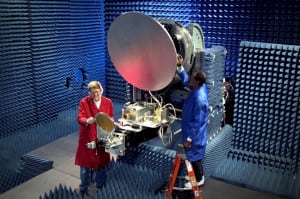Latest News
[Via Satellite 11-03-2014] The U.S. Department of Defense (DOD) needs more time to understand the potential impact of disaggregating large satellites into multiple smaller spacecraft, according to the U.S. Government Accountability Office (GAO). In a report published Oct. 30, the agency questioned the DOD’s readiness for disaggregation, highlighting that decisions made over the next two to three years could have long-term effects on the nation’s space systems architecture.
The DOD is evaluating disaggregation as a way to make satellite systems more resilient to threats such as radio frequency interference, laser dazzling and blinding, kinetic intercept vehicles, and ground system attacks. Spreading out important sensors by placing them on multiple different satellites or as hosted payloads reduces the risk of losing significant capability if one or more satellites are inhibited. If debris were to hit a spacecraft, it would also be less damaging to a constellation as a whole. Furthermore, launch risk could be reduced.
GAO found that the increasing size and complexity of new satellites has contributed to delays and higher acquisition costs in the past. The agency cites the Advanced Extremely High Frequency (AEHF) satellites as an example, where acquisition costs started at $6.7 billion in 2001 and ballooned to $14.5 billion today. Even with the acquisition of an additional AEHF satellite, GAO said design and manufacturing complexity were influencing factors as the satellites grew larger than their predecessors. GAO also notes that, for satellites currently in production, DOD has largely overcome these cost and schedule problems, though they were substantial in previous programs.
Disaggregating large satellites into smaller units could bring costs down in addition to creating a less repressible system. GAO warns, however, that increasing the number of satellites could result in a number of unintended consequences.
“DOD has had limited experience with disaggregating satellites and is still in the relatively early stages of quantifying the costs and benefits of disaggregating its satellites. The potential benefits of disaggregation, such as reduced costs associated with shorter development cycles and simpler designs, have been discussed in various Air Force publications. But less has been said about potential limitations, such as changes that would need to be made to interconnect systems — such as ground stations, user equipment, and communications networks — and the investment those changes would require,” the agency wrote.
GAO pointed out how some satellite control operations networks are designed for only one satellite system, as opposed to shared systems that can operate multiple kinds of satellites, leading to higher costs from potentially duplicative infrastructure and personnel requirements. Continuing with the approach while upping the number of satellites could make these systems much less efficient.
Launch requirements could also change potentially. While smaller satellites are less expensive to launch, the DOD’s long-standing need for large, heavy spacecraft has resulted in launch vehicles tailored to meet that need.
“Without changes to the current architecture, DOD may well find itself having to rely on launch vehicles that are more capable and expensive than needed. Or, it may need to make changes to its approach to launching satellites so that it can rely on smaller launch vehicles or multiple smaller satellites on a single launch vehicle,” GAO wrote.
GAO recommends the Secretary of Defense direct the Under Secretary of Defense for Acquisition, Technology and Logistics to take three steps to prior to making decisions on disaggregating protected satellite communications, the Space Based Infrared System (SBIRS) or any environmental monitoring satellite systems. First is to comprehensively examine every facet of disaggregation — especially those that go beyond just the satellite systems; second is to develop common measures for resilience; and third is to increase the number of demonstrations to better understand its implementation.
Of these three, GAO said the DOD agreed with the first two, and partially agreed with the latter. According to the agency, DOD officials emphasized that for the third point, the U.S. government is evaluating multiple ways to increase resiliency, and that disaggregation is just one approach. Other ideas include building satellites with increased maneuverability or equipping them with defensive capabilities. Large satellites currently under construction could also be enhanced to meet military needs. DOD said it is deciding on the best approach according to the level of affordability, resiliency and capability, and that disaggregation is being evaluated according to this criterion.
Get the latest Via Satellite news!
Subscribe Now